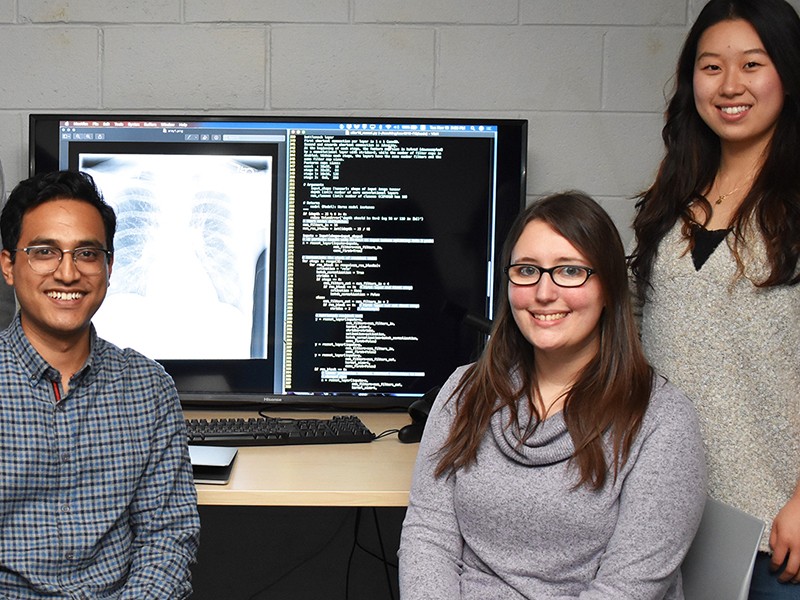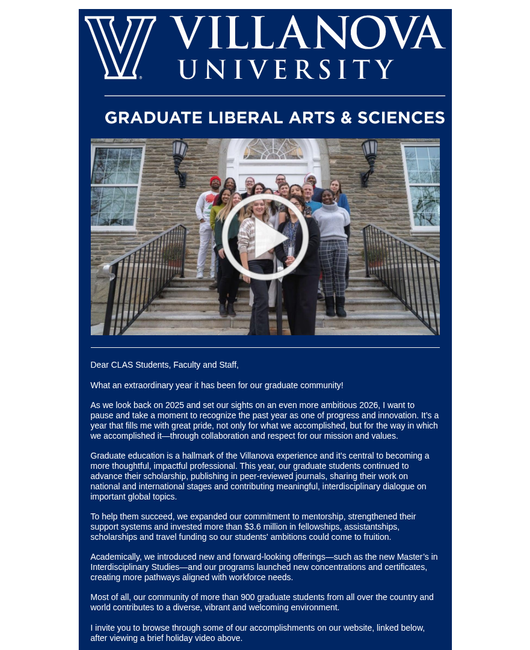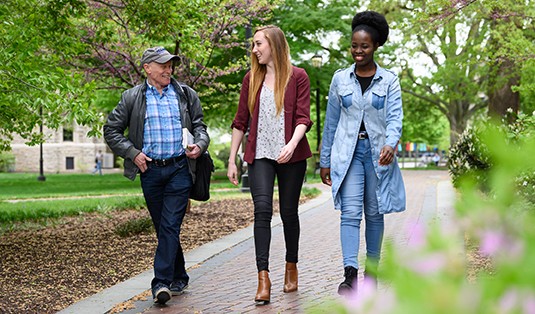Computer Science Alum Shares Insights on How A.I. Can Help Solve Our Most Pressing Problems

Jessica Yarnall '20 MS (seated, right) was part of a Villanova research team that trained artificial intelligence to recognize warning signs in chest X-rays.
There’s been plenty of buzz about artificial intelligence, from sci-fi flicks fretting about a dystopian future to real-life tech leaders fretting about, well, a dystopian future.
The truth is, A.I. already makes a huge positive impact on our daily lives, whether keeping hackers out of our data or recognizing and fixing human error before it causes real harm. In Philadelphia, where our biggest tech innovations often come tied to our growing healthcare industry, that can even mean helping to save lives.
Jessica Yarnall '20 MS is a graduate of Villanova University’s master’s program in Computer Science. In her academic work and in her work as a data analyst at a local children’s hospital, she’s studied and contributed to the major fields of artificial intelligence, from machine learning in data security to deep learning in the healthcare space. We spoke with Yarnall to find out how her career connects with the biggest issues of today, from the pandemic to national security.
Backing Up the Medical Staff
The pandemic has brought attention to the demands of being a healthcare worker. Long hours and limited resources make for a stressful job for medical staff, in addition to what’s already difficult and complex work where a single error can mean the difference between life or death.
Yarnall’s academic work sought to ease that burden a bit.
Yarnall always knew she wanted to help people through healthcare, but she became interested in the analytical side when working in healthcare billing. When she saw that Villanova offered in-person night classes in data science, and she could combine her interests through projects on healthcare, she’d found a place where she could forge a path to a new career and improve patient outcomes.
“It really stemmed from the patient; my interest is that I want to feel like I’m helping people,” Yarnall says.
Her work therefore posed the question: What if artificial intelligence could recognize likely signs of a problem in patients, and help flag issues that the medical staff might have a hard time finding otherwise? To find the answer, Yarnall attempted to train an A.I. to recognize warning signs in chest X-rays.
“We trained and tested it to see how good the algorithms could become at detecting pathology to help physicians understand if there was a particular area of the X-ray they should pay attention to,” Yarnall said. The results of her research contributed to a growing body of work that could aid medical staff in recognizing potential issues with the patient, a kind of safety fence that accounts for human error.
Stopping the Hack Attacks
The ever-growing threat of cyberattacks becomes more concerning as our daily lives grow increasingly dependent on digital programming, from robotically assisted surgery to stock market algorithms.
Yarnall’s research at Villanova extended to defense against adversarial attacks, a kind of attack that breaks image-recognition software.
“It’s where a computer algorithm changes an image so that a human may still recognize an image, but a computer is no longer able to read the image for what it is,” Yarnall says. Skilled hackers can change a single pixel to throw off image recognition software.
According to Yarnall, this becomes especially concerning when you consider that a simple change to the image processing of a smart car can make it unable to read stop signs, or alterations to your phone result in you being locked out from it.
Yarnall was part of a team that used machine learning to run through multiple different image transformations and determine how to reconstruct a readable image automatically—research that was then published and contributed to a large body of research on digital defenses in this area.
That ability to make subjects interesting while connecting them to the real world is one element of her education that drove Yarnall forward in the field.
“At Villanova, we were able to pursue whatever interested us,” she says. “We had professors who would tie the subject back to the real world, and always felt passionate.
Helping the Hospital Help You
There’s been a lot of talk about waste in the healthcare system in recent years, a conversation that became even more urgent with the pandemic. As hospitals became hard-pressed to ration masks, beds and more, the logistics of supply distribution became critical.
Yarnall is part of a growing wave of data analysts entering the healthcare space to improve operations in the years leading up to the pandemic.
“Every field has a need for a data analyst, and especially healthcare,” Yarnall says. “I knew the job market would be strong when I graduated.”
At her job, Yarnall now works on increasing efficiency in the healthcare system, using computer science to better facilitate communication. She uses programming to automatically generate data visualizations and dashboards that make complex data accessible to a wide variety of departments—a must in the hyper-specialized healthcare fields. The visualizations then point out waste, and help stakeholders determine where to direct resources.
“There’s definitely been a lot of communication from leadership saying how helpful the team has been in terms of operations,” Yarnall says.
It was that authentic ability to help others that Yarnall says takes her back to why she entered the field in the first place.
“When you’re in healthcare, you’re not just working for the hospital, you’re helping people,” Yarnall says. “I really enjoy what I’m doing, and I feel like the education that I got at Villanova helps me be successful in what I’m doing now.”
Villanova's Graduate Programs in Computing Sciences include an MS in Computer Science, an MS in Software Engineering and an online Graduate Certificate in Health Informatics.
About Villanova University’s College of Liberal Arts and Sciences: Since its founding in 1842, Villanova University’s College of Liberal Arts and Sciences has cultivated knowledge, understanding and intellectual courage for a purposeful life in a challenged and changing world. With 39 majors across the humanities, social sciences and natural sciences, it is the oldest and largest of Villanova’s colleges, serving more than 4,500 undergraduate and graduate students each year. The College is committed to a teacher-scholar model, offering outstanding undergraduate and graduate research opportunities and a rigorous core curriculum that prepares students to become critical thinkers, strong communicators and ethical leaders with a truly global perspective.


